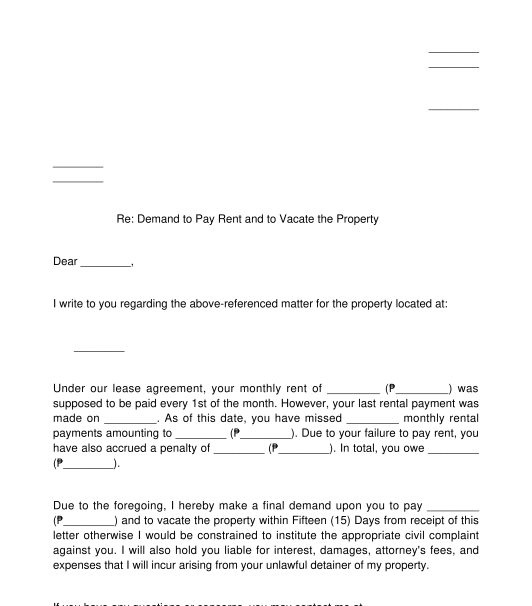 02/16/2024
02/16/2024

Answer a few questions and your document is created automatically.

Your document is ready! You will receive it in Word and PDF formats. You will be able to modify it.

 02/16/2024
02/16/2024
 Word and PDF
Word and PDF
 1 page
1 page
A Demand Letter should be used when the owner of a property wants to recover the possession of the property from a person who is currently possessing the same (the "possessor"). Generally, it is not necessary to send a demand letter before beginning judicial proceedings to recover possession of the property. However, if the judicial proceedings will be for unlawful detainer, it is necessary for the landlord/owner to first send a demand letter to the tenant or the person occupying the property to pay the rent or comply with the conditions of the lease contract and to vacate the property. An exception to this exception is if the unlawful detainer is based on the expiration of the lease, in which case a demand letter is not necessary.
Unlawful Detainer
There is an unlawful detainer when the possessor unlawfully withholds possession of the property after his right to possession is terminated. The right of the possessor to possess the property can come from an express contract, such as a lease agreement, or an implied contract, such as when the owner allows the possessor to enter and stay on the property out of the generosity of the owner.
Examples of unlawful detainer are:
In the given examples, the person in possession of the property had a right to possess the property (because of the lease contract or the consent of the owner) and the said right ended (by the demand of the owner to vacate and surrender the property or the expiration of the lease).
How to use this document
The user will be asked to fill in the general information of the owner and, if applicable, the owner's representative and the possessor of the property, such as their names, addresses, and contact information. The user will also be asked to identify the property and the circumstances surrounding the demand to vacate the property through a series of questions.
For leases falling under the Rent Control Act, as explained below, the tenant can only be evicted from the property after the tenant has missed payment for at least three (3) months.
After completing the document, the user should print the document and have the owner or representative of the owner sign it.
The demand letter can be sent through any means except if the cause is unlawful detainer, in which case, the letter should be sent by:
Applicable law
There are no laws outlining the requirements for a Demand Letter for Eviction except if the cause is unlawful detainer. If the cause is unlawful detainer, the Rules of Court provides that the demand must be to pay or comply with the conditions of the lease and to vacate the property. It also provides for the proper mode of service (or delivery) of the demand letter.
How to modify the template
You fill out a form. The document is created before your eyes as you respond to the questions.
At the end, you receive it in Word and PDF formats. You can modify it and reuse it.
Guides to help you
Other names for the document:
Demand Letter for Eviction, Demand Letter for Unlawful Detainer, Demand Letter for Forcible Entry, Demand Letter for Non-payment of Rent, Demand Letter for Refusal to Vacate and Surrender the Property
Country: Philippines